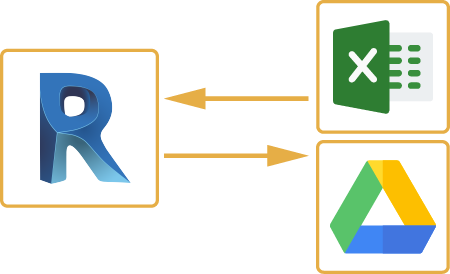Revit Tool Collection: Increase Your Style Capacities
Wiki Article
Revit Accelerator: Excel Combination Techniques for Boosting Performance and Cooperation
In this short article, we will certainly explore the advantages of integrating Excel right into your Revit operations. Plus, we will certainly share best methods for seamlessly integrating Excel right into your Revit projects. Get all set to supercharge your Revit experience with our Revit Accelerator: Excel Integration Methods!Benefits of Excel Combination in Revit
The advantages of Excel assimilation in Revit are various and can substantially enhance efficiency and cooperation. By seamlessly linking these 2 effective tools, you can improve your operations and conserve valuable time. With Excel combination, you can quickly import and export information between Revit and Excel, allowing you to take advantage of the toughness of both programs.
One more advantage of Excel assimilation is the capacity to develop dynamic schedules and reports. By linking your Revit design to an Excel spreadsheet, any type of adjustments made in Revit will instantly upgrade in the corresponding Excel file. This makes it simple to create current schedules, quantity takeoffs, and other project documentation.
Excel integration in Revit also enables better collaboration among employee. With the capacity to import and export information, you can conveniently share details with coworkers that may not have access to Revit. This promotes efficient communication and enables far better control and decision-making.
Simplifying Operations With Revit and Excel
Simplifying operations with Revit and Excel can substantially boost performance and cooperation. By integrating the abilities of Revit and Excel, you can effortlessly transfer data between the 2 applications, removing the demand for hands-on data entry and reducing the risk of mistakes.
Making Use Of Revit and Excel with each other enables you to leverage the strengths of each program - revit add ins. You can export information from Revit right into Excel, where you can carry out complex calculations, develop graphes and graphs, and analyze the information in a more reliable and orderly manner. On the various other hand, you can import information from Excel into Revit, allowing you to swiftly update your versions and paperwork based on changes made in Excel
The assimilation of Revit and Excel additionally promotes collaboration among staff member. By sharing Excel documents, you can conveniently connect and work together on style and construction-related information. This improves coordination and makes certain that everybody is collaborating with one of the most up-to-date info.
Making Best Use Of Partnership With Excel and Revit
To maximize partnership with Excel and Revit, you can effortlessly share and upgrade design and construction-related data with your group. With simply a couple of clicks, you can import Excel spreadsheets into your Revit design, enabling you to conveniently accessibility and manipulate the data.One of the crucial advantages of making use of Master combination with Revit is the ability to update information in both programs at the same time. Any type of adjustments made in Excel will instantly be mirrored in Revit, and the other way around. This ensures that everyone is collaborating with the most updated info, preventing confusion and saving beneficial time.
In addition, Excel provides powerful tools for evaluating and arranging information, which can substantially enhance your partnership initiatives. You can create custom records and graphes in Excel, aiding you to picture and interact crucial job info efficiently. This can be especially useful when offering information to stakeholders or making notified decisions based on task metrics.
Advanced Methods for Improving Performance in Revit Making Use Of Excel
By making use of sophisticated techniques in Revit, you can considerably increase your performance by leveraging the power of Excel. One of the key approaches for improving productivity is by making use of Excel as an information management device. With Revit's Excel combination feature, you can connect Excel spreadsheets straight to your Revit model, permitting you to quickly take care of and upgrade data. This combination enables you to produce schedules, compute quantities, and execute data evaluation effectively.
Furthermore, you can make use of Excel macros to automate repetitive tasks in Revit (import excel into revit). Macros allow you to tape a collection of activities and play them back with a single click, saving you effort and time. You can create a macro to automatically produce space timetables or upgrade criterion values in bulk.
Best Practices for Excel Combination in Revit
Making Use Of Excel as a data administration device in Revit enables for reliable administration and updating of information. One of the finest methods for Excel integration in Revit is to create a clear and organized data structure. By following these ideal techniques, you can properly utilize Excel as a data monitoring device in Revit and boost your performance and cooperation.Final Thought
To conclude, integrating Excel with Revit can significantly improve efficiency and cooperation in the design process. By simplifying workflows and making the most of collaboration, groups can work more efficiently and properly. Advanced revit plugins techniques, such as using Excel macros and solutions, can better improve performance in Revit. Nevertheless, it is necessary to follow finest methods to ensure seamless combination and avoid any type of prospective problems. By leveraging the power of Excel, Revit individuals can accomplish greater levels of efficiency and cooperation in their projects.With Excel integration, you can quickly import and export data in between Revit and Excel, allowing you to leverage the staminas of both programs.
One of the essential advantages of Excel assimilation is the capacity to make use of Excel formulas and features within Revit. By linking your Revit design to an Excel spreadsheet, any type of modifications made in Revit will immediately upgrade in the equivalent Excel documents. On the various other hand, you can import data from Excel into Revit, allowing you to swiftly update your versions and documents based on changes made in Excel.
With Revit's Excel combination feature, you can connect Excel spreadsheets straight to your Revit model, enabling you to quickly take care of and update information.
Report this wiki page